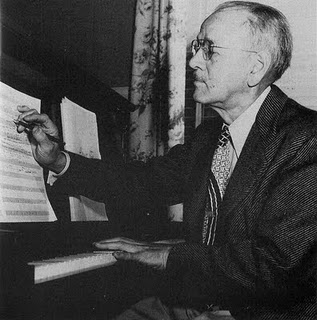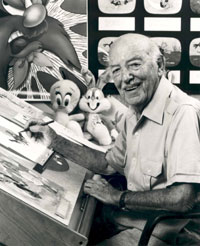
Charles Martin Jones was an American animator, painter, voice actor and filmmaker, best known for his work with Warner Bros. Cartoons on the Looney Tunes and Merrie Melodies series of shorts. He wrote, produced, and/or directed many classic animated cartoon shorts starring Bugs Bunny, Daffy Duck, Wile E. Coyote and the Road Runner, Pepé Le Pew, Marvin the Martian, and Porky Pig, among others.

A storyboard is a graphic organizer that consists of illustrations or images displayed in sequence for the purpose of pre-visualizing a motion picture, animation, motion graphic or interactive media sequence. The storyboarding process, in the form it is known today, was developed at Walt Disney Productions during the early 1930s, after several years of similar processes being in use at Walt Disney and other animation studios.

Limited animation is a process in the overall technique of traditional animation that reuses frames of character animation.

Carl William Stalling was an American composer, voice actor and arranger for music in animated films. He is most closely associated with the Looney Tunes and Merrie Melodies shorts produced by Warner Bros., where he averaged one complete score each week, for 22 years.

An animator is an artist who creates multiple images, known as frames, which give an illusion of movement called animation when displayed in rapid sequence. Animators can work in a variety of fields including film, television, and video games. Animation is closely related to filmmaking and like filmmaking is extremely labor-intensive, which means that most significant works require the collaboration of several animators. The methods of creating the images or frames for an animation piece depend on the animators' artistic styles and their field.

Isadore "Friz" Freleng, credited as I. Freleng early in his career, was an American animator, cartoonist, director, producer, and composer known for his work at Warner Bros. Cartoons on the Looney Tunes and Merrie Melodies series of cartoons from the 1930s to the early 1960s. In total he created more than 300 cartoons.
While the history of animation began much earlier, this article is concerned with the development of the medium after the emergence of celluloid film in 1888, as produced for theatrical screenings, television and (non-interactive) home video.
Maurice James Noble was an American animation production designer, background artist and layout designer whose contributions to the industry spanned more than 60 years. He was a long-time associate and right-hand man of animation director Chuck Jones, especially at Warner Bros. in the 1950s. His work contributed to such cartoon classics as Duck Dodgers in the 24½th Century, What's Opera, Doc? and the Road Runner series.

Traditional animation is an animation technique in which each frame is drawn by hand. The technique was the dominant form of animation in cinema until the end of the 20th century, when there was a shift to computer animation in the industry, specifically 3D computer animation.
Concept art is a form of visual art used to convey an idea for use in films, video games, animation, comic books, television shows, or other media before it is put into the final product. Concept art usually refers to world-building artwork used to inspire the development of media products, and is not the same as visual development art, though they are often confused.
Warner Bros. Cartoons, Inc. was an American animation studio, serving as the in-house animation division of Warner Bros. during the Golden Age of American animation. One of the most successful animation studios in American media history, it was primarily responsible for the Looney Tunes and Merrie Melodies series of animated short films. The characters featured in these cartoons, including Bugs Bunny, Daffy Duck, and Porky Pig, are among the most famous and recognizable characters in the world. Many of the creative staff members at the studio, including directors and animators such as Chuck Jones, Friz Freleng, Robert McKimson, Tex Avery, Robert Clampett, Arthur Davis, and Frank Tashlin, are considered major figures in the art and history of traditional animation.
James H. "Shamus" Culhane was an American animator, film director, and film producer. He is best known for his work in the Golden age of American animation.
An animation director is the director in charge of all aspects of the animation process during the production of an animated or television film, or an animated segment for a live action film or television show. Alternatively, the animation director can be the animator in charge of correcting layouts and drawings for the above media. The difference between the two is largely in the difference between the western and eastern animation industries.
Hawley B. Pratt was an American film director, animator, designer and illustrator. He is best known for his work for Warner Bros. Cartoons and as the right-hand man of director Friz Freleng as a layout artist and later as a director. Pratt also worked for Walt Disney Studios, Filmation, and DePatie-Freleng Enterprises where he co-created The Pink Panther.
Benjamin Alfred Washam was an American animator who is best known for working under director Chuck Jones for nearly 30 years. According to his World War II draft registration, he was born in Newport, Jackson County, Arkansas.

Kenneth B. "Ken" Anderson was an American animator, art director, layout artist, and storyboard artist at Walt Disney Animation Studios for 44 years. He had been named by Walt Disney as his "jack of all trades".

Peter J. Alvarado Jr. was an American animation and comic book artist. Alvarado's animation career spanned almost 60 years. He was also a prolific contributor to Western Publishing's line of comic books.
John Burton McGrew was an American animator, painter and musician. Although best known for working at Warner Bros. Cartoons, where he was the studio's first designated layout artist, working under Chuck Jones, he was also known as a member of the Hollywood blacklist.
Robert Herman Givens was an American animator and character designer, responsible for the creation of Bugs Bunny. He was the leading character designer for Leon Schlesinger, creating over 25 successful characters for both Leon Schlesinger Productions and later Warner Bros. Cartoons. He also did the storyboards and layout designs. He worked for numerous animation studios during his career, including Walt Disney Animation Studios, Warner Bros. Cartoons, Hanna-Barbera, and DePatie–Freleng Enterprises, beginning his career during the late 1930s and continuing until the early 2000s. He was a collaborator with the Merrie Melodies/Looney Tunes directors at Warner Bros. and Chuck Jones' production company.
Glenn Valentin Vilppu is an American fine artist, draftsman, painter and art instructor. Vilppu is internationally known for teaching and training professionals in the animation industry. He has worked as a layout artist on numerous animated feature films and television shows with Walt Disney Animation Studios, Marvel Productions and Warner Bros. Animation. His books and videos are used by universities, art schools and independent students around the world.








